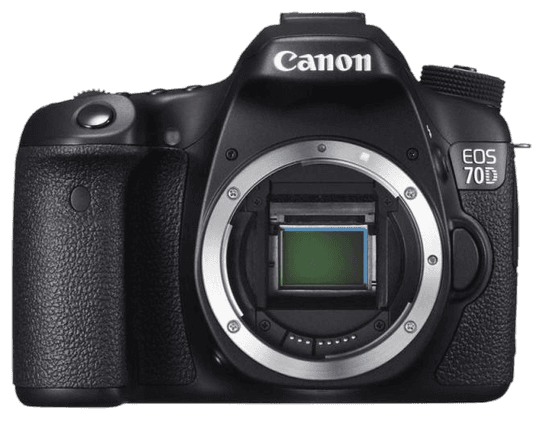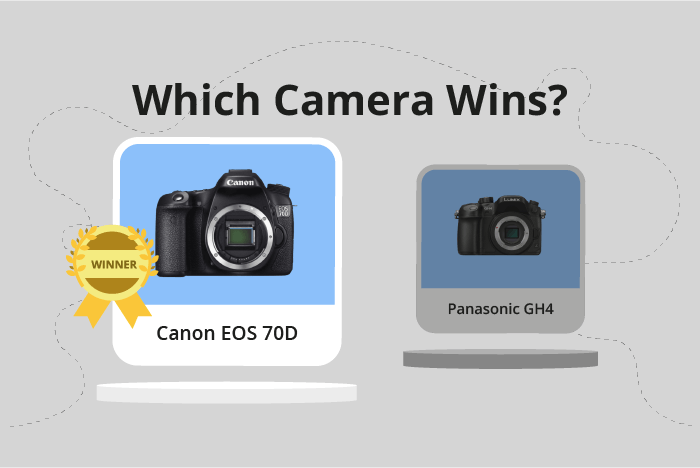Canon EOS 70D vs Panasonic Lumix DMC-GH4 Comparison
Canon EOS 70D

Panasonic Lumix DMC-GH4

The Canon EOS 70D narrowly edges out the Panasonic Lumix DMC-GH4 with a score of 60/100 compared to the GH4’s 58/100. Both cameras share some common specifications, such as being released in the early 2010s (2013 for the 70D and 2014 for the GH4) and having similar dimensions. However, the 70D is a DSLR, while the GH4 is a mirrorless camera.
The Canon EOS 70D’s higher score reflects its strengths as a DSLR camera. With a launch price of $1199, it is more affordable than the GH4, which was priced at $1700 upon release. Additionally, the 70D has a slightly larger size (139 x 104 x 79mm) compared to the GH4 (133 x 93 x 84mm).
On the other hand, the Panasonic Lumix DMC-GH4 is a lighter camera, weighing only 560g (1.23lbs) compared to the 70D’s 755g (1.66lbs). This makes the GH4 more convenient for on-the-go photography.
Taking these factors into account, the Canon EOS 70D may be a better choice for those looking for a more affordable and slightly larger DSLR camera, while the Panasonic Lumix DMC-GH4 may be more suitable for photographers seeking a lighter, mirrorless option.
Canon EOS 70D vs Panasonic Lumix DMC-GH4 Overview and Optics
The Canon EOS 70D outperforms the Panasonic Lumix DMC-GH4 in optics with a score of 58/100, compared to the GH4’s 52/100. Both cameras share some common specifications, such as CMOS sensor type, lack of image stabilization, and a similar processor – the Canon featuring the Digic 5+ and the Panasonic boasting the Venus Engine IX.
The EOS 70D excels with a higher megapixel count of 20.2 compared to the GH4’s 16, allowing for greater image detail. Additionally, the 70D has a larger sensor size (APS-C) compared to the GH4’s Micro Four Thirds sensor, providing better low-light performance and a shallower depth of field. The Canon camera also uses the Canon EF-S lens mount, which offers a wider variety of lens options compared to the GH4’s Micro 4/3 mount.
However, the Panasonic GH4 has its advantages, particularly in its faster shooting speed of 12 frames per second compared to the 70D’s 7 fps. This makes the GH4 more suitable for capturing fast-moving subjects. Furthermore, the GH4 has a higher DXOMARK sensor score of 74, indicating potentially better overall image quality compared to the 70D’s score of 68.
To conclude, the Canon EOS 70D has superior optics due to its higher megapixel count, larger sensor size, and broader lens compatibility. On the other hand, the Panasonic Lumix DMC-GH4 offers better performance in fast-paced shooting situations and potentially higher overall image quality. Ultimately, the choice between these two cameras depends on the specific needs and preferences of the photographer.
Canon EOS 70D vs Panasonic Lumix DMC-GH4 Video Performance
The Panasonic Lumix DMC-GH4 emerges as the winner in terms of video capabilities, scoring 70 out of 100, while the Canon EOS 70D scores 43 out of 100. Both cameras share some common specifications, such as Full HD video resolution and the ability to record 1920 x 1080 videos.
The GH4 outperforms the 70D in several aspects. The most significant advantage is its 4K video resolution, allowing it to capture videos at a maximum dimension of 4096 x 2160. This results in higher quality and more detailed videos compared to the 70D. Additionally, the GH4 has a maximum video frame rate of 24fps, which enhances the cinematic look of the videos. Another advantage of the GH4 is the built-in time-lapse functionality, enabling users to create stunning time-lapse videos without the need for additional equipment or software.
On the other hand, the Canon EOS 70D has its own edge over the GH4 with a maximum video frame rate of 30fps, providing smoother motion in videos compared to the GH4’s 24fps. This feature is particularly useful for capturing fast-moving subjects or creating slow-motion effects.
In terms of video capabilities, the Panasonic Lumix DMC-GH4 is the superior choice due to its 4K video resolution, 24fps frame rate, and built-in time-lapse functionality. However, the Canon EOS 70D’s higher frame rate of 30fps may appeal to users looking for smoother video playback. Ultimately, the decision will depend on individual preferences and specific video requirements.
Canon EOS 70D vs Panasonic Lumix DMC-GH4 Features and Benefits
The Canon EOS 70D and Panasonic Lumix DMC-GH4 both have a feature score of 70 out of 100. These cameras share several specifications, including a 3-inch screen size, touchscreen capabilities, flip screens, no GPS, WIFI connectivity, and no Bluetooth.
The Canon EOS 70D has a slightly higher screen resolution at 1,040,000 dots compared to the Panasonic Lumix DMC-GH4’s 1,036,000 dots. This difference in resolution provides the EOS 70D with a marginally better image display on its screen.
On the other hand, the Panasonic Lumix DMC-GH4 offers no clear advantage over the Canon EOS 70D in terms of features. Both cameras have the same score, and their specifications are quite similar in this category.
Considering the shared specifications and similar feature scores, both cameras perform well in their respective fields. The Canon EOS 70D has a minor advantage in screen resolution, but this difference is not significant enough to declare it the overall winner. The Panasonic Lumix DMC-GH4 does not outperform the EOS 70D in any specific feature, but it holds its ground as a competitive option for photographers.
When choosing between these two cameras, potential buyers should consider other factors such as price, brand preference, and additional features not covered in this comparison. The Canon EOS 70D and Panasonic Lumix DMC-GH4 both offer a solid set of features for photographers, and the final decision will depend on individual preferences and priorities.
Canon EOS 70D vs Panasonic Lumix DMC-GH4 Storage and Battery
The Panasonic Lumix DMC-GH4 outperforms the Canon EOS 70D in storage and battery with a score of 60/100 compared to 37/100. Both cameras share similarities in accepting SD, SDHC, and SDXC memory cards and lacking USB charging capabilities.
The GH4 offers a clear advantage with two memory card slots, allowing for more storage and backup options. However, it falls short in battery life with only 500 shots, compared to the 70D’s impressive 920 shots. The Canon EOS 70D uses an LP-E6 battery type, while the GH4 uses a DMW-BLF19 battery type.
Though the GH4 leads in storage capabilities, the 70D shines in battery life, providing photographers with more time to capture moments without needing to change batteries. Each camera excels in different aspects, with the GH4 being a better choice for storage and the 70D for battery life.
Alternatives to the Canon EOS 70D and Panasonic Lumix DMC-GH4
Are you still undecided about which camera is right for you? Have a look at these popular comparisons that feature the Canon EOS 70D or the Panasonic Lumix DMC-GH4:

